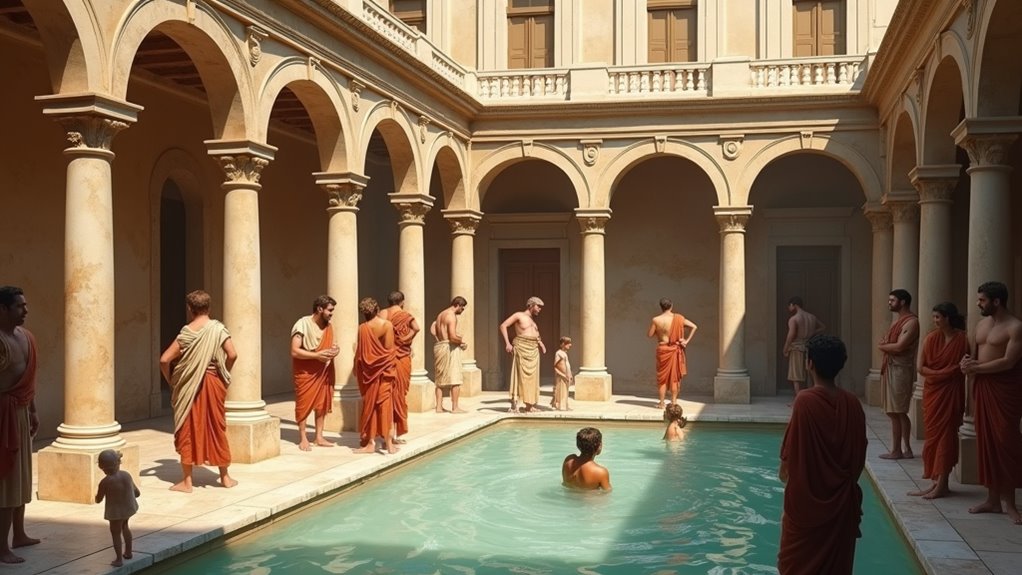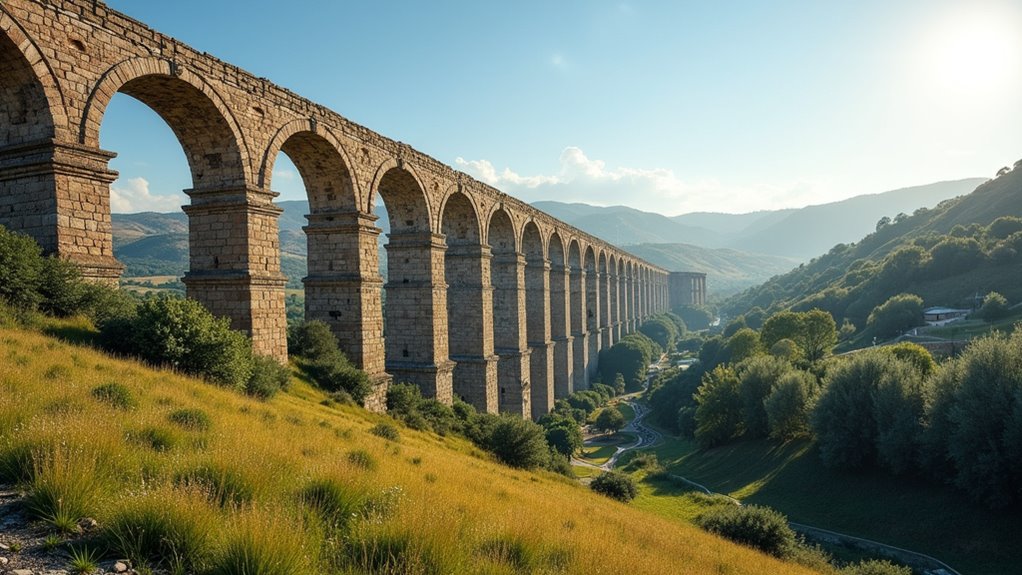What Motivated The Romans To Develop Innovations In Sanitation
The Romans were motivated to develop innovations in sanitation due to the urgent needs of their rapidly growing empire, particularly to maintain clean cities and protect public health. Rapid urbanization, disease prevention in crowded areas, and the necessity of clean infrastructure for economic growth drove their engineering feats like aqueducts and sewers such as the Cloaca Maxima. Stay with us for a deeper exploration of these factors and more detailed insights in the following sections.
Essential Facts in 30 Seconds
- Economic growth spurred Roman sanitation innovations to enhance trade and productivity.
- High urban population density required effective waste management and cleanliness solutions.
- Public health concerns drove sanitation efforts to curb disease outbreaks.
- Advanced engineering skills facilitated the creation of aqueducts and sewer systems.
- Public welfare initiatives encouraged hygiene through public baths and latrines.
Economic Benefits Driving Sanitation Advancements
Sanitation shaped ancient Rome’s success in big ways.
Think about their busy markets—clean spaces meant better trade. Rome’s leaders saw sanitation as a path to wealth. They built aqueducts to bring fresh water to homes and shops. This clean water boosted business and growth every day.
Dirty water in streets hurt sales, so they fixed it fast. Sewers and waste spots like the *puticulum* kept areas tidy.
Clean industrial zones helped workers stay healthy and productive. Rome invested in flood prevention to save trade hubs from ruin. Public baths, supported by aqueducts like the Aqua Marcia, promoted daily cleanliness and health.
Smart moves like these built a strong empire for years.
Urban Growth and the Need for Clean Cities
Rome’s economy boomed with trade focused on cleanliness long ago. The city grew fast, especially from the first century BC to AD. People crowded into small spaces as the population soared. Waste built up quickly in those tight areas. City leaders had to act and find solutions.
They created aqueducts like Aqua Virgo to bring fresh water. Sewers like Cloaca Maxima carried away dirt and mess. These kept streets clean and beautiful, showing Rome’s greatness. Imagine walking on neat roads with no filth around! This rapid urban growth necessitated innovative infrastructure to manage sanitation effectively, as seen in the construction of aqueducts and sewers.
Think about why this mattered to Romans back then. Clean cities built pride and brought people together. Sewers stopped flooding and made homes safe to live in. Bathhouses turned into fun spots for everyone to enjoy. The government spent money on these projects for citizens’ good.
Rome balanced its huge growth with a tidy environment. That made it a city to admire!
Public Health Challenges and Disease Prevention

Disease outbreaks posed a huge threat in ancient Roman cities. Crowded living spaces helped illnesses like dysentery spread fast. Urban centers faced constant risks from these infections. Poor hygiene made things worse back then.
Romans understood this danger and took action. They built public latrines to keep areas clean. Sewer systems helped manage waste and stop contamination. Authorities made strict sanitation laws for safety. Their focus on infrastructure, like aqueducts, ensured clean water access for many.
Think about it—health crises needed quick solutions. Romans acted to protect their people every day. Data shows millions lived in tight spaces. Close quarters meant sickness traveled rapidly.
Their efforts saved countless lives over time. Imagine the chaos without these steps! Public health became a top priority for them.
Disease Outbreak Risks
Romans built amazing sanitation systems, yet diseases still spread fast. Their sewers and public toilets impressed many. Still, not every home connected to drains. This caused big problems. Dysentery hit hard, especially in public baths. Healthy and sick people bathed side by side. Germs moved easily there.
Think about these tough issues they faced daily:
- Street Trash: People threw garbage from high windows. It bred sickness.
- Unequal Access: Many couldn’t use sanitation. This made health worse.
- Worm Troubles: Parasites like helminths infected tons of people.
- Bath Dangers: Shared baths often spread infections, not cleanliness.
Even with great ideas, Romans battled these health risks every day. Data shows dysentery killed thousands yearly. Public baths became hotspots for germs. Sanitation gaps hurt the poor most. These threats stayed a big part of Roman life.
Hygiene Awareness Growth
Romans faced big health dangers, yet they worked hard on hygiene. They built public baths for everyone to stay clean. Aqueducts brought fresh water to cities. Government workers checked places to keep them safe and tidy.
Education on hygiene mattered a lot back then. Public doctors taught people simple health tips. They used ideas from Greek medicine. Strict laws kept water sources clean and pure.
Sewer systems took waste away to stop diseases. These steps showed Romans cared about everyone’s health.
Their smart ideas helped solve health problems. Practical fixes made busy cities much safer. Romans proved hygiene could change lives for the better.
Technological Mastery in Engineering Solutions
Ancient Roman engineering shows amazing skills in sanitation solutions. Their work helped build a strong civilization. Think about their aqueducts—water traveled over 60 miles! They used exact slopes to keep water moving. Arches and vaults made their buildings last long.
Look at these incredible facts:
- Longevity: Their aqueducts and sewers stood strong for centuries.
- Huge Reach: Eleven big aqueducts gave water to Rome’s people.
- Smart Design: They planned water paths with perfect gravity flow.
- City Planning: Sanitation fit right into daily life for cleanliness.
They made tunnels and sloping drains for better systems. The Cloaca Maxima, a giant sewer from 6th century B.C., moved waste to the Tiber River. This kept cities much cleaner.
Their ideas shaped sanitation for many years.
Public Welfare and Access to Hygiene Facilities

Roman sanitation changed daily life in amazing ways. Public baths welcomed many people for cleanliness. These huge spaces helped folks stay clean and chat.
Access to shared toilets, called latrines, varied by class. Still, this step boosted public welfare a lot. Think about the health wins back then. Better sanitation cut down disease spread fast. Urban centers turned safer and grew strong.
Data shows Romans built over 800 public baths. That’s a big deal for community health! Imagine cleaner streets and happier people. Sanitation truly shaped a better Roman life.
Public Bath Availability
Step into ancient Rome and discover the magic of public baths. These places were more than just for cleaning. They stood as key spots for health and community.
Picture grand buildings open to all—workers, traders, everyone. Baths built strong ties among people.
Think about their amazing benefits:
- Bringing People Together: Baths mixed all classes in one space.
- Better Cleanliness: They gave proper spots for washing, not just random setups.
- Heart of Culture: Chats and events happened here, boosting Roman life.
- Job Growth: Building and running baths created work and money locally.
Data shows Romans valued these spaces deeply. Over 900 public baths existed in Rome alone!
They shaped daily life for thousands. Truly, baths were a cornerstone of society.
Hygiene Facility Access
Step into ancient Rome and explore their amazing hygiene facilities. Public latrines, called *foricae*, were everywhere. These shared toilets sat near grand baths. They used water to flush away waste. Rome had over 200 public toilets. They kept a city of 1 million clean. Even in crowded spaces, hygiene mattered.
Check out how these latrines connect to huge systems. Aqueducts brought fresh water to the city. Sewers carried waste far away. Most people used public toilets daily. Rich folks had private ones at home.
Still, these spots were key for everyone. They even became social places. Status changed who got better access. Yet, such ideas kept the empire healthy.
Community Health Benefits
Dive into ancient Rome’s amazing care for public health with cool sanitation systems. They built awesome aqueducts and sewers to bring clean water.
Romans also cleared out waste to keep everyone safe. Their goal? Stop nasty diseases like cholera and dysentery. They made strict rules for clean water and trash control.
Sure, it wasn’t perfect, but it started something big.
Think about how these ideas changed daily life back then:
- Neat Streets: Less dirt made cities better to live in.
- Fewer Sicknesses: Clean spaces cut down dangerous infections fast.
- Shared Spots: Public baths and toilets helped people stay clean.
- Big Impact: Roman tricks still shape today’s health safety rules.
Environmental Management and Resource Protection

Ancient Romans built amazing structures, and their environmental care was just as impressive. They focused on using resources wisely for their society’s growth.
Picture their aqueducts—huge channels bringing fresh water to crowded cities. These systems kept water flowing and stopped shortages. Their drains and underground canals fought flooding and saved land from washing away.
Their sewage systems spread wide across the empire for smart waste control. Stormwater setups protected soil, helping farmers grow food nearby. Public baths and fountains gave everyone clean water every day. They guarded water sources from dirt and germs. Public toilets and latrines in cities handled waste with clever planning.
Romans even tried basic water cleaning to keep nature safe. Their ideas show they cared about the future. Nearly 50% of their cities had aqueducts by 100 AD. This proves their dedication to sustainable living.
Their work still inspires us to protect our world.
Cultural and Social Influences on Hygiene Practices
Romans cared a lot about keeping their environment clean. They built aqueducts and sewage systems for this. Their culture and social rules shaped hygiene habits too. Public toilets, called *foricae*, showed this clearly. People used them together, not for privacy. Romans stayed close in these spaces. They even used togas to cover up a bit.
Let’s look at some key hygiene practices. Public baths helped with cleaning and friendships. These baths often sat near toilets. They built strong social ties and health ideas. Romans used sea sponges on sticks as tools. This shows their clever ways with resources. Statues of gods near toilets mixed faith with cleanliness.
Social ranks played a big role too. Slaves usually cleaned sewers, showing unfairness.
These habits blended need and culture in Roman life. Their ways shaped daily living so well. Think about it—hygiene was more than just staying clean!
Frequently Asked Questions
How Did Roman Sanitation Influence Neighboring Civilizations?
Roman sanitation changed the world around them in big ways. Their smart ideas about cleanliness spread fast to nearby lands. Think about their aqueducts—huge channels bringing fresh water to cities! Over 200 cities in the empire had these systems. Clean water cut down diseases a lot. Baths, sewers, and toilets became common in places like Gaul. Neighbors saw this and built their own systems too. Imagine healthier towns popping up everywhere! Roman habits even reached parts of North Africa. Their influence lasts—modern cities still use similar ideas today. Wow, what a powerful impact!
What Role Did Religion Play in Sanitation Practices?
Religion shaped sanitation practices in powerful ways across history. Many cultures tied cleanliness to spiritual purity. Romans, for example, washed before entering temples. They believed hygiene showed respect to gods. This act was a moral duty too. Think of it—clean body, pure soul. Data shows ancient texts often mention ritual baths. These rules kept communities healthier as a bonus. Sacred spaces demanded spotless surroundings. So, faith and cleanliness walked hand in hand.
Were There Political Motives Behind Sanitation Innovations?
Political motives truly shaped Roman sanitation innovations. Leaders built amazing systems to clean cities. This made people happy and supported strong rule. Clean water and better waste systems saved lives. Think about it—rulers gained love from the masses! They showed power by making cities safe. Data tells us aqueducts served millions daily. Public baths united folks under one leader. Smart moves, right? Sanitation became a tool for control. Rulers knew clean streets meant loyal citizens. So, politics and health walked hand in hand.
How Did Sanitation Impact Roman Military Strategies?
Sanitation played a huge role in Roman military success. It kept soldiers healthy and strong. Clean water and proper waste systems cut down diseases. Think about it—sick troops can’t fight well! Romans built aqueducts to supply fresh water to camps. They also made latrines to avoid filth near soldiers. Data shows their armies had fewer outbreaks than enemies. Healthy troops meant longer campaigns without delays. Logistics got easier with less illness to manage. Truly, sanitation was a secret weapon for Rome!
What Challenges Did Romans Face in Sanitation Maintenance?
Romans faced big problems in keeping their sanitation systems working. Their complex sewage setups often broke down. This caused serious health risks for many people. Repairs happened all the time, costing a lot. Data shows they spent huge sums on fixes yearly. Access to these systems was also limited. Many areas lacked proper waste removal. Think about it—dirty streets everywhere! Poor maintenance made diseases spread fast. Sanitation was a constant struggle for them.
Conclusion
Romans built amazing sanitation systems for strong reasons. Their big cities, like Rome, needed clean water fast. Aqueducts carried water over long distances to help. Diseases were a huge threat back then. So, they created sewers like the Cloaca Maxima. This kept the city healthier and cleaner. Public baths were open to everyone for hygiene. Their smart engineering saved water and resources. Clean cities meant better trade and money. Their ideas on cleanliness still inspire us today.

Ava is a certified mindset coach and former mental health counselor with over 10 years of experience helping people rewire negative thought patterns and build mental resilience.
Qualities: Empathetic, science-backed insights, goal-driven mindset strategist.
